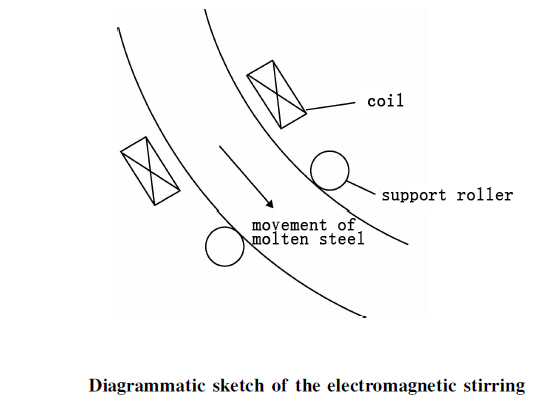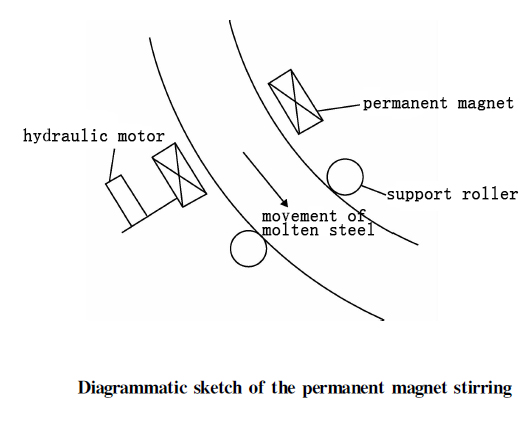Electromagnetic stirring has become an important technical means to improve the quality of billets in continuous casting processes. Compared with the traditional three-phase AC electromagnetic stirring (EMS), the rotating permanent magnet stirring (PMS) based on sintered Nd-Fe-B material has the advantages of high Magnetic flux density, low power consumption and simple structure. The technical characteristics of electromagnetic stirring and permanent magnet stirring were mainly compared, and the application status of permanent magnet stirring in the billet continuous casting mold and solidification end was introduced; The permanent magnetic stirring inside the mold effectively improves the surface and internal quality of the billet, significantly reduces surface small hole defects, and improves the central porosity and carbon segregation of the billet; When applied to the solidification end of high carbon steel continuous casting, with the increase of the rotational speed of the permanent magnet stirring magnet, the central carbon segregation index of the billet significantly decreases, and the electrical energy consumption per ton of steel is only about 15% of that of traditional electromagnetic stirring.
In the past decade, through the development of electromagnetic theory and experience accumulation, as well as the improvement of solidification quality of steel products, the application of continuous casting electromagnetic stirring has become increasingly common. During this period, the progress of submerged electromagnetic wire materials, the rapid development of electronic devices and frequency conversion control technology provided a good hardware foundation for electromagnetic stirring, and the equipment procurement and maintenance costs of continuous casting enterprises in this area were greatly reduced. Therefore, the rapid development of electromagnetic stirring technology has gradually become a highly effective and cost-effective standard configuration for controlling the quality of casting billets. In order to control the quality of the billet, the vast majority of continuous casting machines have installed and used electromagnetic stirrers through the introduction of equipment, technological transformation, and localization of equipment.
Compared with the traditional three-phase AC electromagnetic stirring, the permanent magnet stirring has significant advantages such as less power consumption, high Magnetic flux density and simple structure. The permanent magnet stirrer does not require a high-power variable frequency power supply, only a motor to drive the permanent magnet, and the electrical energy consumption is much less than that of the AC electromagnetic stirrer. In addition, the structure of the stirrer is relatively simple and does not require the use of coils. It does not require high water quality for cooling water, and there will be no similar problem of electromagnetic stirrer coils failing due to insulation damage. In recent years, permanent magnet stirring has caused a technological revolution in the aluminum industry, with the main purpose of homogenizing the composition and temperature of alloy melts. Under the same conditions, the energy consumption of permanent magnet stirring is much lower than that of electromagnetic stirring, which has obvious energy-saving advantages. Therefore, permanent magnet stirring is widely used in various non-ferrous alloy smelting heating furnaces, while there are few reports on the application of rotating permanent magnet stirring in the steel continuous casting industry. This article mainly compares the technical characteristics of electromagnetic stirring and permanent magnet stirring, and combines the author's research foundation in continuous casting permanent magnet stirring in recent years to analyze, summarize, and prospect the application status of permanent magnet stirring in the billet continuous casting mold and solidification end.
At present, the most widely used stirrer is the traditional three-phase AC electromagnetic stirrer, as shown in Figure 1. The mechanism of electromagnetic stirring is that by applying three-phase symmetrical alternating current to the coil winding, the current changes over time and excites a rotating magnetic field distributed along the circumference in the inner cavity of the stirrer, which changes with the current. The changing magnetic field in turn triggers an induced current in the molten steel. Under the interaction between the induced current and the magnetic field, a Lorentz force is generated in the molten steel, driving the flow of molten steel in the billet. The adjustable variables of electromagnetic stirring are stirring current and frequency. The Magnetic flux density is mainly controlled by adjusting the current intensity to control the movement of molten steel. Crystallizer or end electromagnetic stirring has almost become the standard configuration for quality control of billet continuous casting.

The electromagnetic stirring of the crystallizer accelerates the movement of molten steel, increases the proportion of equiaxed grains, and is conducive to the removal of bubbles and inclusions, improving the surface and internal quality of the billet. The electromagnetic stirring at the secondary cooling zone and solidification end can break the columnar crystals, prevent bridging, expand the equiaxed crystal zone, and improve center segregation; Electromagnetic stirring at the solidification end is widely used, effectively improving the central segregation of the billet and reducing porosity. Taking the high carbon steel billet continuous casting machine as an example, the combination of mold electromagnetic stirring and solidification end electromagnetic stirring is generally used to synergistically improve the quality of the billet, and the application effect is good. In order to drive the molten steel to rotate, the electromagnetic stirrer is generally made into an AC three-phase system. In order to obtain a strong magnetic field, the stirrer often adopts a small number of turns and a high current method. The current density inside the wire of the stirrer coil can be as high as 12-15 A/mm2. The stirrer must be cooled by water with a certain pressure flow, and generally requires a preparation, circulation, and cooling system with high requirements for pure water. Considering that the coil has been immersed in water for a long time, despite the use of high-quality cooling water, the online continuous operation life of the coil is still relatively short.
Permanent magnet stirring is widely used in the aluminum industry, but there is limited research in the steel industry. The permanent magnet stirrer is shown in Figure 2. The structure of the permanent magnet stirring device is mainly divided into three parts: the permanent magnet, the mechanical part that drives the rotation of the permanent magnet, and the cooling system used to ensure that the permanent magnet does not demagnetize due to temperature rise. The magnet of the permanent magnet stirrer adopts the high temperature resistant Nd-Fe-B permanent magnet block. The permanent magnet generates a strong static magnetic field of special shape in the center of the stirrer, and the central Magnetic flux density is determined by the permanent magnet material. The mixer has a relatively simple structure and does not require the use of coils, resulting in low requirements for the quality of cooling water. The permanent magnet stirrer has the advantages of high magnetic field strength and simple structure.

The permanent magnet stirrer belongs to the AC induction type and is similar in principle to a three-phase AC electromagnetic stirrer. The working principle of a permanent magnet stirrer is to use a motor to drive the permanent magnet to rotate, thereby generating a strong magnetic field that rotates; The interaction between the rotating magnetic field and the induced magnetic field in the billet liquid core generates electromagnetic force, which drives the metal liquid core to rotate and stir. The different inlet oil pressures of hydraulic devices correspond to different rotational speeds, and different magnetic field rotational speeds correspond to different stirring frequencies. Before installing the permanent magnet stirrer, the magnetic field strength can be controlled by selecting permanent magnets with different magnetic field strengths or adjusting the installation distance of the permanent magnet. After installation, the speed can only be mechanically adjusted, which is equivalent to the frequency of AC induction to change the electromagnetic force.
Compared to traditional three-phase AC electromagnetic stirring, a permanent magnet stirrer only requires a motor to drive the permanent magnet, resulting in a higher magnetic field strength and less energy consumption; At the same time, there is no need to use coils, and there is no high requirement for cooling water quality, with a simple structure; Therefore, the rotating permanent magnet stirrer has the advantages of large Magnetic flux density, low power consumption, simple structure, etc.
The environment of the continuous casting machine is harsh, and permanent magnets are sensitive to temperature. With the rapid development of magnetic materials, the improvement of the high-temperature resistance of neodymium iron boron permanent magnets is conducive to promoting the further development of permanent magnet stirrers; In addition, when designing the movement mode of the stirrer magnet, it is necessary to fully consider the long-term stable and reliable operation of the driving motor.
The on-site test results show that permanent magnetic stirring in the mold effectively improves the surface and internal quality of the billet, significantly reduces surface small hole defects, and effectively improves the central porosity and carbon segregation of the billet; When applied to the solidification end of high carbon steel continuous casting, the carbon segregation index at the center of the billet significantly decreases with the increase of the rotational speed of the permanent magnet stirring magnet.
Contact: Cindy Wang
Phone: +86 19916725892
Tel: 0512-55128901
Email: [email protected]
Add: No.6 Huxiang Road, Kunshan development Zone, JiangsuShanghai Branch: No. 398 Guiyang Rd, Yangpu District, Shanghai, China